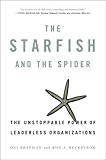 Exploring the literature on networks and living systems, I recently read The Starfish and the Spider: The Unstoppable Power of Leaderless Organizations by Ori Brafman and Rod Beckstron. Brafman’s and Beckstrom’s book describes examples of centralized and decentralized organizations. Because I’ve got sons in law (Andy and Nathan) who are independent musicians, I enjoyed this book’s discussion of decentralized organizations like Napster, Kazaa, and emule and how they (iTunes included) have revolutionized the music industry and continue to challenge the big, centralized music labels (for a related discussion, see also my review of The Long Tail by Chris Anderson).
Exploring the literature on networks and living systems, I recently read The Starfish and the Spider: The Unstoppable Power of Leaderless Organizations by Ori Brafman and Rod Beckstron. Brafman’s and Beckstrom’s book describes examples of centralized and decentralized organizations. Because I’ve got sons in law (Andy and Nathan) who are independent musicians, I enjoyed this book’s discussion of decentralized organizations like Napster, Kazaa, and emule and how they (iTunes included) have revolutionized the music industry and continue to challenge the big, centralized music labels (for a related discussion, see also my review of The Long Tail by Chris Anderson).
Within these examples and many others, they argue that leaderless organizations . . and the way they grow and thrive . . . are part of the story of the genius of powerful movements. At the heart is the metaphor describing the difference between a starfish and a spider:
Cut the head off a spider and it dies; cut a leg from a starfish and it grows a new one which becomes another starfish. The spider is centralized (it has a head), while the starfish is decentralized: Each arm carries everything needed to survive. Thus, a starfish would survive if you cut it in half. Actually, each half would survive and could very well grow new arms. A starfish is not depending on one central part of the body, as the spider is depending on the central head.
Building on this basic difference, Brafman and Beckstrom identify 8 major principles of decentralization–not surprisingly many of the same characteristics of living systems and networks that we’ve been discussing in other posts.
1) When attacked, a decentralized organization tends to become even more open and decentralized.
2) It is easy to mistake a starfish organization for a spider organization.
3) An open system–ie the starfish–doesn’t have central intelligence; the intelligence is spread throughout the system.
4) Open systems can easily mutate.
5) The decentralized organization sneaks up on you.
6) As industries become decentralized, overall profit decrease.
7) Put people into an open system and they’ll automatically want to contribute.
8) When attacked, centralized organizations tend to become even more centralized.
There is a balanced tone to this book. At the end of it, Brafman and Beckstrom encourage “the combo special: the hybrid organization”, combining centralized features with decentralized ones–proving perhaps that no organization can truly be leaderless. Nevertheless, these features of “leaderless organizations” explain in part the organic nature and life of mass movements.
Leave a Reply